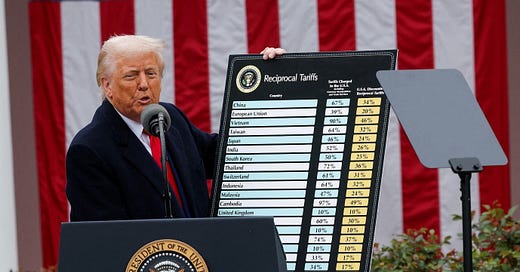Last Wednesday, on what he dubbed “Liberation Day,” Donald John Trump announced a slew of tariffs aimed at addressing what his administration says is the unfair treatment of America on the international trade stage. Trump and his administration have long viewed the size of America’s trade deficit as a sign that America has not been getting a “good deal” when it comes to international trade.
Trump says that this new tariff, which he characterizes as “kind,” will help correct the trade injustice that America has faced, revive manufacturing, and raise revenue (his team estimates that the tariffs will bring in about 6 trillion USD over ten years, but independent experts say the actual figure is more like 3.1 trillion USD over ten years).
Trump’s tariff formula (pictured below) is essentially a country’s net trade balance with the US divided by the total imports from that country to the US. That figure is then divided by two, implying that the US is only charging half the tariffs being imposed by their trading partner. Hence the characterization of the new tariffs as “kind”, but anyone with a basic understanding of economics will tell you that is not how tariffs or their impact is calculated.
So What?
First of all, I need people to understand that when a country imposes tariffs, it’s the citizens of that country that bear the burden of the tariff. So, when you say this tariff will make xxx pay for ripping us off, you are the one actually footing the bill.
That out of the way, international trade is one of the most complex parts of economics because it is one of the aspects most affected by politics, and the actions of different actors cannot be deterministically predicted. However, based on historical precedent, we can say for sure that these policies are going to drive inflation in the USA because tariffs increase prices of goods and services (also, they are a form of consumption tax and so are regressive in nature, meaning the impact will be felt more by the poor than the rich). Given that the American economy is driven by consumer spending, the tariffs are expected to reduce American GDP growth by about 0.5 percentage points (which does not sound like a lot until you realize that 0.5% is the equivalent of about 140 billion US dollars or twice the economy of Ghana).
There are a lot more economic implications too that we can explore, like the fact that 40 percent of the revenues of companies listed in the S&P 500 come from abroad, so this will affect stock growth prospects, or the impact it will have on export-led economies like Vietnam (which got slapped with 46%).
What is really funny to us is that we don’t think all this economic pain is worth it in the first place. First, he says that the trade deficit is proof that the rest of the world is ripping off America, but 60 percent of that deficit is with China, the EU, and Mexico; the rest is scattered across Europe and Asia. Most countries have a surplus with the United States so a tariff on them will no improve the deficit. Addressing the issues from China’s abuse of WTO agreements is important, but these blanket tariffs don’t do that.
Second, the type of manufacturing that you can just uproot and move around is not the type that Americans will want. I don’t think Americans will be lining up to work in shoe and garment factories, and when you look at advanced manufacturing, that takes a lot of planning and investments (financial and non-financial) that you cannot just tariff into existence.
And on the matter of raising taxes, we have already talked about this being a regressive tax that will punish mostly the poor.
Ultimately, history shows that this does not work. The solution to America’s industrial problems is a deliberate recalibration of the economy to support the development of new industries and, very importantly, create policies that ensure wage growth matches worker productivity.







